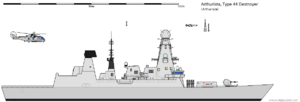Type-44 destroyer

| |
| Class overview | |
|---|---|
| Name: | Type-44 Class Destroyer |
| Builders: | Arthuristan Dynamics |
| Operators: |
list error: <br /> list (help) Commonwealth Navy Royal Orlessian Navy |
| Preceded by: | Phobos-class destroyer |
| General characteristics | |
| Type: | Destroyer |
| Displacement: | 8,800 tonnes |
| Length: | 152.4m |
| Beam: | 21.2m |
| Draught: | 7.4m |
| Propulsion: | CODELAG, two shafts, 105,000 shp |
| Speed: | 30kn |
| Range: | 7,000+ nm at 18kn |
| Complement: | 191 (accommodation for up to 235 |
| Sensors and processing systems: |
|
| Armament: |
|
| Armour: | steel shrapnel sheets, kevlar spall liners |
| Aircraft carried: | Hangar for 1x medium or 2x light helicopters |
The Type-44 "Prometheus" Class is an Arthuristan class of air defence destroyer. First entering service with the in 2005, the class of eight ships represents the fleet's premier anti-air capabilities and are intended to protect the new Vengeance-class fleet carriers from all manners of aerial threats, including aircraft, supersonic sea-skimming and high-diving anti-ship missiles, as well as anti-ship ballistic missiles.
Design
The Type-44 is a dedicated air defence design. The heart of the ship is its ATHENA integrated digital combat system. It relies on a combination of the SATURN X-band AESA multifunction radar and the S1850M volume search radar to detect and track more than 1,000 air targets out to 400km, including low-RCS targets with radar returns as small as cricket balls, and simultaneously engage a large number of them with the AD-12 Area Defence Missile or quad-packed AD-16 Adder. The volume search radar has the added advantage that, as most stealth shaping is intended to defeat X-band radars, it is capable of providing early warning against relatively stealthy threats.
The primary armaments of the ship is its anti-air missile battery, consisting of a 61-cell V90 Vertical Launch System arranged in eight blocks of eight hot-launch tubes. One block sacrifices three cells for the installation of a compact folding crane system which allows for the replenishment of the launch cells in calm sea states. The normal missile load is 48x AD-12 Area Defence Missiles, complemented by 52x quad-packed AD-16 Adder.
In addition, the class is armed with eight ACM-2 Renove or ACM-13 Lilith anti-ship missiles, a 4.5-inch gun, triple launchers for MU90 Impact lightweight anti-submarine torpedoes or torpedo-interceptors, and a battery of miniguns and autocannons for close range defence against small crafts in littoral areas.
The first ships were initially equipped with a pair of Phalanx CIWS for close range missile defence. Later vessels possess the SeaRAM missile system and older ships are being gradually retrofitted.
Type-44 vessels are also equipped with an integrated counter-measures suite. Its Type-3091 Electronic Support Measure/Electronic Countermeasures (ESM/ECM) Suite is capable of sampling and tracking radiation signals and jam hostile radars and radio datalinks. It is also equipped with the Multi Ammunition Softkill System and Surface Ship Torpedo Defence system.
There exists a proposal to replace the main gun with a 127mm weapon, capable of firing guided shells. There seems to be little enthusiasm for such a project in the Admiralty, where many question the notion of risking a multi-billion, highly sophisticated air defence ship inshore for land attack missions. Some consider that it would be more appropriate to replace the 4.5-inch gun with a 76mm Strales mount for improved close-range missile defence.
Construction and service
Originally, it was envisaged that twelve Type-44 vessels would be constructed, as one-to-one replacements of the Phobos-class destroyers. However, the requirement of combining and integrating so much cutting edge technology led to costs to spiral out of control. In the end, it was decided to terminate the construction program after the eighth ship. The gap thus created would be filled by frigates of the Agni Class which, although lacking some of the Type-44's top end functionalities, such as ballistic missile defence, are highly-capable air defence vessels in their own right.